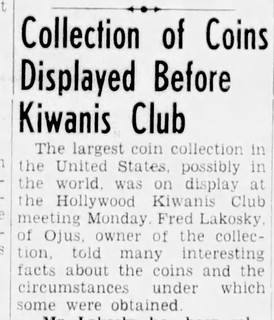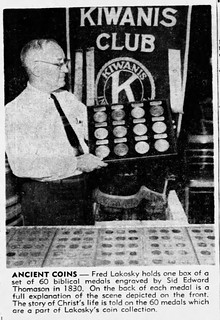
PREV ARTICLE
NEXT ARTICLE
FULL ISSUE
PREV FULL ISSUE
FREDERICK HERBERT LAKOSKY (1894-1968)E-Sylum Feature Writer and American Numismatic Biographies author Pete Smith submitted this article on forgotten collector Fred Lakosky of Wisconsin and Florida. Thanks! -Editor
Frederick Herbert Lakosky (1894-1968)
I was intrigued by an article in the Hollywood Herald of November 2, 1951. I was unfamiliar with Fred Lakosky. What could I learn of the collector and his collection? Lakosky was born in Newton, Wisconsin, on August 6, 1894. He was the son of Peter Laskowski (1863-1940) and Maria Susanna Zimmer (1863-1968). Peter was a farmer and later the owner of a saloon. In various records, the family name is spelled Laskowski and Laskoskie. When he was four years old, he searched for Indian arrowheads on his father's farm near Manitowoc, Wisconsin. He also claimed that he found a 1652 pine tree shilling. He saved his allowance to expand both collections. Lakosky was married to Susana Rysticken (1896-1929) on January 29, 1917. At the time he was employed as a ships carpenter. They had three children. His first wife died on March 1, 1929, as the result of an earlier fall. By the 1930 Census in April 1930, he was married to Frances Ann Will (1908-1987) and living with two of his sons. By the 1940 Census, he had a daughter and a son with his second wife. In 1926 he was elected president of Loyal, Wisconsin, a town with a population less than a thousand. He served as mayor of Loyal for 19 years until he moved to Florida. In 1929 he was the proprietor of the Loyal Implement Store. He also had a 160-acre farm three-quarters of a mile east of Loyal. Lakosky was generous in sharing his collections with the public. At a Loyal antique show in 1934, Lakosky exhibited a clay tablet from Babylon claimed to be 3500 years old. He also had Swedish plate money dated 1741, United States paper money dated 1771 to 1778 and "all the issues since that time." In 1940 he was selected as chairman of the county draft board. He refused to classify cheese workers as 1A believing they provided an essential service at home. He was a director of the Citizens State Bank and a charter member of the Loyal Rotary Club. In 1943, he displayed his coin collection to the Neillsville Kiwanis and Rotary Clubs. The coins were displayed in shallow trays with all the coins cemented on green felt. The trays fit into a carrying case. On October 1, 1945, he joined the American Numismatic Association as member 11707. The Numismatist reported on his activities with the Miami Coin Club where he frequently exhibited parts of his collection. Many times he would show coins or crowns from a letter or two of the alphabet. He moved to Florida in 1946. Before leaving, he had a liquidation sale of his business inventory and advertised that he was attempting to sell his collection of 1000 books and 27,000 stamps. In 1949, he had an armed escort to the International Invention and Hobby Show in Miami. His collection with an estimated value in excess of $50,000 was shown in the booth of the Miami Coin Club. The collection was described as "a complete series of United States currency and coins from 1862 to the present day." One of the coins was described as: "A half dime made in the Philadelphia mint April 2, 1792, and one of the first coins minted by the U. S. government. According to the Standard Catalog of U. S. Coins, it was made from George Washington's personal silver." (I first read about this on the morning of Friday, October 25, 2024.) He also had an 1802 half dime I did not know about.
"There's only one of those known to be in existence. I bid $1,070 for it some years ago but lost out to Baltimore's Louis Eliasberg who owns a fine collection." Leo Young conducted a sale in 1958 that included "The Famous Fred Lakosky Collection of Crowns and Talers of the World." This included more than 2000 pieces. One special coin was a 12 Taler of Brunswick-Luneberg with two examples known. In 1959 he showed Indian relics at the Dania Bank lobby. He reported that a Miami museum was interested in buying his collection. On September 12, 1962, Lakosky opened the door for two visitors interested in buying coins. They beat him, bound and gagged him. They carried off a small safe, two thousand silver dollars and boxes of old coins. Two men were charged in the robbery and three more were charged with receiving stolen property. In 1963, he exhibited his collection of Indian relics at the First National Bank in Hollywood. He made some interesting statements that I believe were incorrect. "The hard flint arrow and spear heads are particularly interesting, because as far as anyone can find out – and the world's best archeologists have studied the matter very thoroughly – the art of chipping the hard flint was lost in antiquity. Probably more than 10,000 years ago." He also stated, "No relics of any consequence have ever been found in northern states." I could recount the hundreds of flint chips and intact arrowheads I found on a Minnesota beach in the 1960's. He died in a hospital in Hollywood, Florida, on December 1, 1968, and is buried at Lauderdale Memorial Park in Fort Lauderdale. A search of "Louis Eliasberg" on the Newman Numismatic Portal yields 1605 hits. A search of "Fred Lakosky" yields just seven. Both exhibited their collections to the public. There are published rosters for surviving examples of the 1792 half disme, the 1802 half dime and the 1894-S dime. The Lakosky name does not appear on any of these lists. What happened to the coins from his collection? Lakosky got little attention from the numismatic press during his lifetime. There was no public sale of his collection to indicate the quality of the coins. There was no promotional hype that goes with the sale of a collection. This article provides more information about him than all previous articles combined.
Confusion
Fred Lakosky is not a common name. During the period of 1948 to 1968, there may have been three people named Fred Lakosky living in Florida. Frederick Herbert Lakosky (1894-1968) was the former mayor of Loyal, Wisconsin, and coin collector then living in Ojus, Florida, four miles south of Hollywood. Frederick P. Lakosky (1938-2018) was a police officer in Hollywood and the son of Fred H. Lakosky and his second wife Frances. Frederick L. Lakosky (1924-1981) was a real estate agent and developer. His 1981 obituary lists his survivors as including brother F. P. Lakosky and sister Mary Huey, making him a son of Frederick H. Lakosky. He shares a date of death with Verland Leo Lakosky, second son of Frederick H. It appears that he assumed the name of Fred about the time he moved to Florida in 1948. For a while I had him confused with his father. Thanks, Pete! It's hard work to pull together these threads of information and sort through the confusion. It's great to resurface an obscure collector with a major collection. Keep your eyes out for the name Fred Lakosky - it could be a new piece of the puzzle illuminating the fate of his collection and enhancing the pedigree chains of a number of rarities. -Editor
Wayne Homren, Editor The Numismatic Bibliomania Society is a non-profit organization promoting numismatic literature. See our web site at coinbooks.org. To submit items for publication in The E-Sylum, write to the Editor at this address: whomren@gmail.com To subscribe go to: https://my.binhost.com/lists/listinfo/esylum All Rights Reserved. NBS Home Page Contact the NBS webmaster 
|


